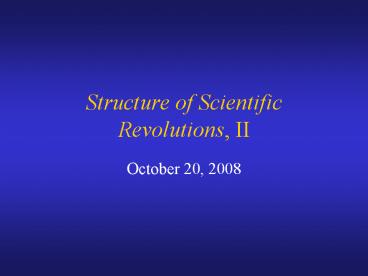Structure of Scientific Revolutions, II - PowerPoint PPT Presentation
1 / 12
Title:
Structure of Scientific Revolutions, II
Description:
... those [phenomena] that will not fit the box are often not ... Determination of significant facts. e.g., acidity of solutions. Matching of fact with theory. ... – PowerPoint PPT presentation
Number of Views:56
Avg rating:3.0/5.0
Title: Structure of Scientific Revolutions, II
1
Structure of Scientific Revolutions, II
- October 20, 2008
2
Normal Science
- mopping-up operations are what engage most
scientists throughout their careers. that
enterprise normal science seems an attempt to
force nature into the preformed and relatively
inflexible box that the paradigm suppliesthose
phenomena that will not fit the box are often
not seen at all. Nor do scientists normally aim
to invent new theories, and they are often
intolerant of those invented by others.(24)
3
Normal Science
- Determination of significant facts.
- e.g., acidity of solutions.
- Matching of fact with theory.
- e.g., telescopic observations of planetary
positions. - Articulation of the theory.
- e.g., determination of the gravitational
constant.
4
Chapter IV
- Perhaps the most striking feature of the normal
research problems we have just encountered is how
little they aim to produce major novelties,
conceptual or phenomenal. Science does not
aim at unexpected novelty. (35) - - Positive publication bias.
5
Chapter IV
- Q Why do scientists take on research?
- A Though its outcome can be anticipated, often
in detail so great that what remains to be known
is itself uninteresting, the way to achieve that
outcome remains very much in doubt. Bringing a
normal research problem to a conclusion is
achieving the anticipated in a new way, and it
requires the solution of all sorts of complex
instrumental, conceptual, and mathematical
puzzles. (36)
6
Chapter IV
Normal, paradigm science consists of
puzzle-solving.
The challenge of cleverly solving the puzzle is
why scientists pursue research.
7
Puzzle-solving
- guarantees a solution.
- leads to success.
- is what the individual scientist does.
- is constrained by the paradigm.
- Newton example
- Phlogiston example
- Dark matter/MOND example
8
Scientific Rules
- Rules about what specific sorts of things exist,
and what kinds of relations obtain. - Rules about preferred sorts of instrumentation.
- Rules about what the world is like, generally.
- Highest-level rules.
Ontological Rules
Experimental Rules
Metaphysical Rules
Methodological Rules
9
Scientific Rules
- Normal science is a highly determined activity,
but it need not be entirely determined by rules.
(42) - Normal science only partly determined by these
rules. - Normal science is not all there is to science.
10
Differences from Popper
- Popper scientists are creative and daring.
- Kuhn scientists are puzzle-solving addicts.
- Popper scientists are constantly open to new
things. - Kuhn scientists are close-minded in an important
way.
11
Is the puzzle-solving feature of normal science
good?
- Kuhn Yes! For progress, we need to close-off
areas of inquiry. - Ex. Political disputes.
12
Critiques of Kuhn
- Only one paradigm per scientific field?
- Is commitment to a paradigm really the way that
Kuhn describes? - Is such strong commitment really a good thing? Is
it necessary?































